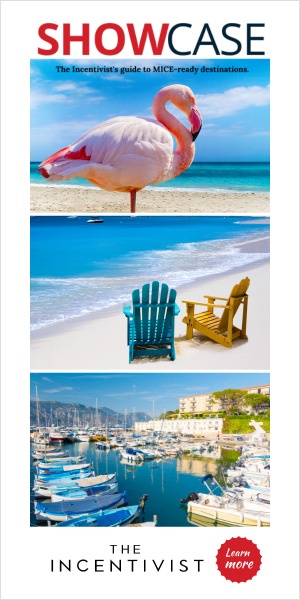Increasing demand for long haul destinations, a growing emphasis on the experience economy and incentives with wider reach are three of the nine trends impacting the incentives industry this year, according to the Incentive Research Foundation’s (IRF) just-released 2020 Trends Report.
The key areas of change and their implications for workforce engagement, incentive travel and recognition identified in the study are:
Executives support of incentive programs is strong—most of the time
The study reveals that 94% of executives at top-performing firms are strong supporters of incentive programs and consider them a competitive advantage. This support tends to result in increased investment and visibility in the organization, which allows programs to grow, program designers to enhance offerings, and often provides funding and program rules that include a greater number of participants. According to the IRF's Industry Outlook for 2020, 19% of program cancellations were due to lack of executive support (down from 26% as reported in the 2019 Outlook study). Example: Report that the Charles Schwab Corp. scaled back its incentive trip to Hawaii, citing "reputational risk" associated with award programs.Reporting and analysis are growing
Pressure to prove the value of programs is increasing along with the amount and type of analysis required. In the IRF's Industry Outlook for 2020, the foundation reported that corporate users conducting analysis on how programs change behaviour increased to 44%, compared to 25% in 2019. Most organizations measure effectiveness based on correlations. Metrics for tangible benefits include decreased staff turnover, increased productivity, sales, revenue, market share, gains in customer satisfaction, and customer acquisition. Metrics for harder-to-measure intangible benefits include employee satisfaction, collaboration, and impact on company culture. The Incentive Travel Industry Index also reported a stronger executive focus on "soft power" (e.g., engagement, productivity, relationships) boosting the role of incentive travel as a builder of corporate culture and engagement.Participant satisfaction is new top metric
According to the Incentive Travel Industry Index, participant satisfaction was ranked as the most important metric to demonstrate the value of an incentive program to senior management. These findings are reinforced by the IRF’s Industry Outlook for 2020, which reported that the satisfaction level of participants is the most common measure of program success used by both corporate (68%) and third parties (80%).Emphasis on the Experience Economy
The study reports that for incentive travel to be a true reward, it needs to be unique, fresh, and authentic to the destination. According to the Incentive Travel Industry Index, 73% of DMCs, DMOs, and suppliers indicated that offering one-of-a-kind, exclusive experiences was the top method to add value. Experiencing the destination and building relationships through meals remain top rated items for successful incentive travel programs.Closer to home, program designers are also creating memorable experiences for program participants. With a focus on participant preferences, rewards include guitar lessons, spa days, cooking classes, products that support hobbies, and access to new restaurants. Some companies are hosting incentive events and gifting in high-end retail locations, such as Fendi and Armani. At events, the traditional “gifting suite” has evolved into a marketplace experience where attendees can select and often customize gifts based on their preferences.
Demand for long-haul destinations growing
The Incentive Travel Industry Index reports that Western Europe and Central America are the top long-haul destinations used by North American buyers. As the focus sharpens on the experience economy, program participants are craving new destinations and new experiences. Planners are expanding their searches to second- or third-tier destinations so that participants experience something new and unique. According to the Incentive Travel Industry Index, North American buyers showed favorable interest in Oceania, Southeast Asia, and Central America, with approximately 9-12% more buyers expected to increase use of those destinations over the next two years.Personalization is key
Program designers are developing innovative ways to include personalization throughout their programs in order to make a lasting impression on program participants. Using participant data, gift card and merchandise options are customized so that the program participant’s reward aligns with their interests and is therefore viewed as a valuable and memorable reward. Incentive event planners survey attendees prior to the event in order to provide attendees customized experiences, meals, and gifts based on their personality traits and expressed preferences. Personalization requires a higher level of data collection and analysis, as well as a longer lead time.Managing risk online and on-site
Marriott’s massive data breach affecting the records of up to 500 million customers demonstrates a potential risk to any business that collects customer information. As incentive software becomes more sophisticated and program owners collect more participant data, the risk of being hacked also increases. Use of multiple platforms, as well as transferring data among platforms and vendors also expose data to potential threats. Investment and commitment to data security will continue to be critical to the incentives industry. Regulations, such as the European Union's 2018 implementation of the General Data Protection Regulation (GDPR) and California Consumer Privacy Act (CCPA), which went into effect in January 1, 2020, are also driving increased measures to improve data management and security.The Incentive Travel Industry Index noted that challenges around safety, security, and marketplace uncertainty were the most important negative factors impacting programs planned for 2020 and 2021. The increased security requirements for travellers before arriving (ETIAS 2021, Canada CR/TRP) are creating the need to educate the customer to avoid issues at departure. Additional security concerns include border security between countries, terrorism, natural disasters, and general marketplace uncertainty. Planners are investing more in security reviews prior to contracting, including background checks, extra security personnel, and additional risk management support from the venue.
Wider reach more important than exclusivity
In order to motivate and engage a larger number of program participants, designers are structuring programs with a wider reach, with the goal of each participant receiving recognition or rewards. According to the 2020 Top Performer Study, top performing firms are 64% more likely than average performing firms to design programs with the goal of broad reach rather than exclusively rewarding top performing program participants. Many program owners are running multiple or tiered programs, often including an incentive trip for the top tier performers and rewarding additional participants with merchandise, gift cards, or local experiences.Gift cards are impactful and easy to give
As reported in the IRF’s Industry Outlook for 2020, gift cards continue to be widely used, with median gift card amount remaining at $100. The Fall 2019 issue of the IRF Quarterly Academic Review summarized research showing gift cards have the potential to capture most – and perhaps all – of the well-known benefits of non-cash rewards. Program awardees categorize gift card gifts as “fun money.” Many employers find gift cards easy to give and to administer compared to choosing specific tangible gifts or rewards.Branded gift cards that align with the likes and interests of the recipient deliver greater perceived value than an equivalent open gift card or cash. In 2019, online retailer gift cards outpaced coffee, which was 2018’s top gift type. Retailers that are exclusively online (e.g., Amazon) are currently the most popular type of gift card (65%)—ahead of coffee (61%). Sixty-nine percent of corporate purchases occur at retail locations, such as grocery and drug stores, when robust options exist for plastic card fulfilment and digital rewards through gift card distributors and incentive companies.















